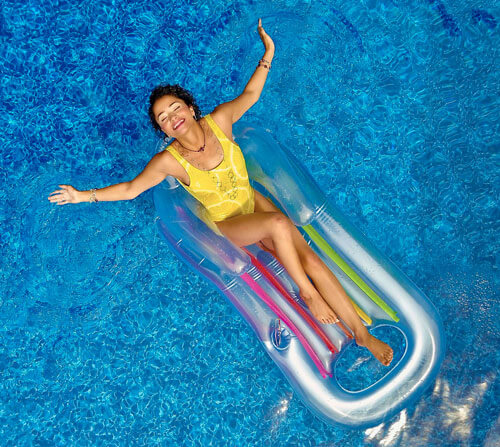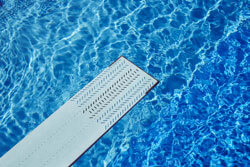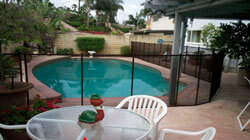
Upgrading Your Existing Pool Fence: DIY Options for 2025
Find the best pool fence options for upgrading your DIY removable mesh pool fence. These are our top suggestions to get the pool fence idea juices flowing.

Nothing says summertime quite like an open pool. Keeping in mind the best time to open your pool in your area, here is your essential checklist for how to open an inground pool.
Your first step in how to open your pool for summer is to remove any debris that may have collected on top of or trapped underneath your pool cover. Leaves, sticks, dirt, and more can build up on top of or around your cover. If you don’t sweep it off before storing the cover for summer, the debris can fall into the water and be more troublesome to clean or potentially affect your pool’s chemical balance. Gently collect the leaves and debris and pile them away from the pool area.
Every brand of pool cover is slightly different to remove, but share the same basic premise — unless you have an automatic cover. Start by unattaching the anchors keeping your cover in place. Next, find a helper with a free pair of hands. Each of you take a hold of the cover at one end, then walk it over and out across the length of the pool.
Once removed, clean and store your pool cover out of the sun. Cleaning your cover before storage is an essential step, so don’t skip it!
If you use a pool net as your cover, you may need the extra step of skimming large debris and leaves out of your pool once you store the net. Pool nets, while highly effective safety tools when used correctly, do not typically keep leaves and other matter from falling into the water.
The next step when digging into how to open an inground pool is preparing your filtration system.
Even if you had a tightly fitting pool cover and there wasn’t much large debris, chances are there are tiny bits of sediment that found their way into your pool’s water throughout winter, clouding it. While your filtration system was idle during the colder months, it now has its work cut out for it to prep for summer.
Take this opportunity to check and clean your filter, O-rings, and pipes. Ensure there are no cracked or dry O-rings and replace those if necessary. Clean the filter thoroughly and make sure drain plugs are secure.

The next step in how to open an inground pool is to replace deck equipment like pool ladders, step rails, or diving boards. Check for rust or worn nuts and bolts, then re-install your equipment.
When you prepare a pool for winter, you’ll often want to drain the pool to below the filter line so that water does not freeze inside any pipes. You may have also lost a few inches of water from evaporation. Take this opportunity to fill your pool to capacity before you fire up your filtration system.

Once your water levels are solid and your filtration system is ready to go, start the system. To open an inground pool, cleanliness is key! So with the filtration running, grab your pool brush and give the sides and bottom of your pool a thorough scrubbing.
Brushing dirt that’s stuck to the walls and floor of your pool while the freshly cleaned filtration system is on means that dirt gets filtered out right away. Nothing looks more inviting than a pool with clean, freshly scrubbed walls.
When your filtration system is humming smoothly and your pool is sparkling clean, your next essential step in how to open your pool for summer is to check your chemical levels. During winter, pool chemicals become depleted, so it’s vital to ensure they’re at proper levels before using your pool.
Be extra safe when engaging in this opening inground pool how-to. Wear gloves and use only professionally vetted pool water test kits. Make sure the balance of your chemicals follows these guidelines:
Let your pool’s filtration system run for a full 24 hours before opening your pool for swimmers. This time frame allows you to be sure your chemicals remain in balance, that there are no issues with the filtration system, and that you’ve gotten all large debris out of the water that could otherwise potentially clog your pipes.
The final step in how to open your inground pool is our highest priority: keeping your pool area safe.

Whether you replace your pool net, put up/double-check your pool fence, or replace the batteries in your pool alarm (we recommend all three!), the safety of your newly opened pool is paramount.
Implementing a pool safety barrier to protect those most at-risk — like children, pets, and the elderly — can mean the difference between life and death when seconds count. All-Safe has specialized in this life-saving area for more than 20 years, so trust us when we say your family’s safety is in the front of our minds.
From pool nets to fences to alarms, All-Safe products are strong, easy to use, and dependable. Let our local dealer’s uniformed, professional team provide you with a free onsite consultation and exceed all your pool area needs. Contact us today to schedule your appointment.

Find the best pool fence options for upgrading your DIY removable mesh pool fence. These are our top suggestions to get the pool fence idea juices flowing.

The top pool fence accessories can help you get the most from your backyard oasis. Take a look at our top recommendations and learn how to pick the gear that’s right for your pool safety fence installation.

Building a fence on uneven ground doesn’t have to compromise your family’s safety. Learn our top tricks for measuring and understanding your land’s dips, bumps, and slopes so you can keep your loved ones safe.
Enter your zip code to locate an independent installer in your area
Enter your zip code to locate an independent installer in your area
Enter in your zip code to let us know where your pool is located.
Due to the many variations in monitors, phones, and browsers, color samples and product examples may appear different on different screens. Computers and mobile devices are not all calibrated equally and color reproduction on the Internet is not precise. The same is true for printed items such as brochures and other sales literature.
In addition, the colors of our products photograph differently under different lighting conditions. For example, photos taken in full sunlight will vary from photos taken on a cloudy or overcast day. Similarly, shadows from nearby objects can affect the color and transparency of our products. If a precise color or specific shade is important, please inspect the actual color of your product prior to installation.
Many of our products’ materials are not available through typical stores and vendors and therefore must be custom manufactured specifically for our use. In order to control costs and provide you with the best value possible, our raw materials are produced in large batches and can often take several months to receive. The colors of our materials can, and often do, vary slightly from batch to batch. Although we make every effort to minimize color variations, we cannot be responsible for these differences when they occur. If a precise color or specific shade is important, please inspect the actual color of your product prior to installation.
For example, we use the name “putty” to describe some of our products. Your idea of the color “putty” may be different than someone else’s idea of “putty”. In addition, products may have the same color name but may not be the exact same color. For example, we have different shades of “black”. Please do not order using color names as your only guide. If a precise color or specific shade is important, please inspect the actual color of your product prior to installation.
If it is important that your product be an exact color or shade, it is highly recommended that you inspect the actual product prior to its installation and address any concerns with your local independent installer. Most independent installers do not offer refunds or accept returns due to color variations.